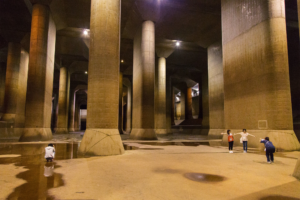How Tokyo is preparing for flooding beyond anything we’ve seen
To hold off the increasing amount of rain that falls on Tokyo every year, civil engineers have designed a colossal underground system to channel inundating waters. Known as the Metropolitan Area Underground Discharge Channel, the system consists of five separate tunnels that sweep excess rainfall away from the city center and into the Arakawa and other surrounding rivers.
Beyond its effectiveness, what makes this system truly impressive is the sheer scale of its structures. Beginning in the city center, each of the channel’s 5 shafts is large enough to accommodate a space shuttle.

At the end of the each shaft sits a 10-meter diameter tunnel that runs for 6.3 km. Although the system’s colossal collection shafts are impressive, at the end of the main system lies an even larger structure — The pressure adjusting tank. Measuring 177-meter long by 78-meter wide the tank, is home to a number of large pumps that drive water into Tokyo’s rivers at a rate of nearly 200 cubic meters per second.
As weather patterns continue to shift, cities will need to develop contingency measures aimed at ever more powerful phenomena. For without unpaved spaces in which water can naturally dissipate, massive engineering projects are the only viable option.
Which means it might not be too long before monumental feats of civil engineering, like the Tokyo discharge tunnel, transition from a place of awe into the everyday reality of our modern civic infrastructure.
